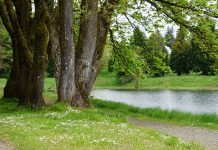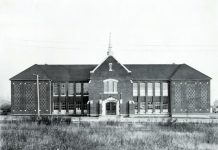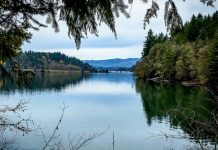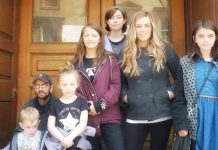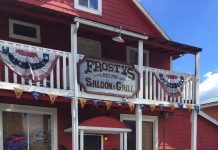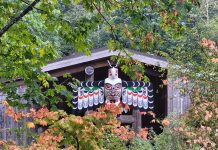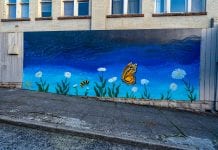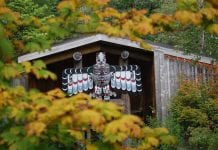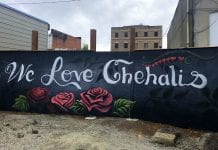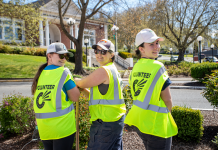Ford’s Prairie in Centralia, Washington is a census designated place which today contains businesses and residences and Ford’s Prairie Elementary School. But it’s seemingly conventional appearance today belies a rich pioneering history with a role in the foundation of Washington State. It all began with the Native Americans who called it home and Sidney and Nancy Ford for whom the prairie was named.
The Journey West
In 1832, only 24 years after the Lewis and Clark Expedition and four years before Charles Ingalls of Little House on the Prairie fame was born, the family of Sidney and Nancy (Shaw) Ford began their western migration. First, they moved from New York to Michigan with their three eldest children Harriet Jane, Sidney Jr. and Thomas, where in 1840 Elizabeth or “Lizzie” was born. By 1842 they had moved to Missouri, where a daughter named Missourie and a son, Fernando, were born. With a babe in arms the Ford family joined a wagon train of 300 other immigrants to journey across the plains to the Oregon Territory.
Early on, four-year-old Lizzie’s shoes were destroyed by fire and she famously made the journey barefoot. Her headstone in Forest Grove Cemetery bears the epitaph, “Her tiny feet a pathway beat across the wilderness.” Many hardships were encountered along the way including the death of a young baby of one of the party’s families.
Encounters with Native Americans became commonplace for the nervous immigrants. As Tove Hodge, great-great grandchild of Sidney Ford recounts in Centralia: The First Fifty Years, “When one came up to the Ford wagon, however, and refused to leave, my great-great-grandfather calmly looked at his wife and said, ‘Nancy, hand me my rifle.’ The Indian left. This was my great-great-grandfather’s first encounter with one of this race.”

Finding Home
In 1845-1846 the Fords wintered in Oregon City of the Willamette Valley, but this was not to be the end of their journey for they desired to see what was north. Sidney, with a group that included Sidney Jr. and Joseph Borst, scouted the region.
The way north meant crossing the Columbia River and a journey by canoe up the Cowlitz to the Hudson Bay Post. From there Indian trails took them through forests and prairies. After crossing the Nisoolups (the Chehalis River) Sidney Ford came to a place of surprising loveliness. Hodge explains, “A wide, open land surrounded by a fringe of firs. A snow-capped mountain loomed up in the east and another to the south. On the west, the river bordered the land in a gentle curve. Brilliant red patches covered the prairie – millions of ripe wild strawberries. My grandfather, moved by its beauty, felt this was his future home.”
The beauty of the place was not lost on the local tribe called the Quiyaisk, who had for generations called the spot “Tasunshun” meaning, “resting place.” To Sidney Ford’s credit, he quickly made friends of the Indians who found him to be kind and honest, and invited him to stay.
The Ford family as a whole made the journey to what would become their 640-acre land donation claim in 1846. The women, children and luggage were all placed in canoes paddled upstream by Indians. The men drove the stock and brought the wagons along the banks. When it came time to journey up the Cowlitz, young Lizzie jumped in a luggage canoe with one of the Indians and started upstream before she was missed. When the rest of the family arrived at the landing, there sat Lizzie blissfully unaware of the anxiety she had caused her family.

Life on the Prairie
Sidney, along with his sons Sidney Jr. and Tom, built a two story 12 by 12 log cabin. Eventually a larger cabin was erected next to the smaller cabin, which was then used as a storehouse. The two structures were so close together that they shared a single exterior staircase. In times of trouble the house was further walled up and fortified with the windows becoming slits through which a gun could be aimed. The house in its fortified state was called “skookum” or “strong.” It was in this small original cabin in 1847, that Mary Angeline came into the world. She was purportedly the first white child born north of the Columbia River.
The prairie proved to be fertile and grew an abundance of wheat and oats, but other supplies still had to be obtained at Fort Vancouver. The trip took so much time, it is surprising they had any supplies left by the time they returned home. Consequently, pioneer wives became very self-sufficient. Nancy was known to tediously grind wheat in her coffee grinder, collect ash to leaven biscuits when baking soda was out and ran ashes into lye to make soap and hominy.
Lizzie, and the other Ford children went on to have a great relationship with the Chehalis Indians. Their children were her playmates and she learned to speak their language fluently, as did Sidney Jr. whose knowledge of the local dialects later enabled him to serve as a translator.
Life for the children on Ford’s Prairie sounded like a lark. The boys were all notorious pranksters, playing tricks on each other and the Indians who lived on the property. The boys were known to run with a rope between them and knock over the little wigwam structures of the Quiyaisk. They took great pleasure in seeing the surprise on the Indian’s faces when their shelter was suddenly tipped over. It was no wonder then that Lizzie rather was the favorite with the Indians. They called her “Lassie” and enjoyed watching her and her brother Fernando (who the Indians called “Kolum” meaning “Sunny” because of his golden hair) as they used lariats to catch the wild Indian ponies. Sunny and Lizzie would then jump on the ponies bareback and dash across the prairie.

A Place in History
Early on, the Ford’s home became an important stopping place for travelers to rest. Fresh horses could be procured there on the trip from Fort Vancouver to the Puget Sound.
In the years to come Sidney Ford fulfilled many important roles in the life of the young Oregon Territory. He was a signer at the Monticello Convention which petitioned the government to create a new territory north of the Columbia River. He became Judge Sidney Ford and an agent to many of the local tribes. His friendship and trust with his Indian friends would be tested time and again throughout the Indian Wars. He stayed with his family in their big Skookum house while anywhere from 200 to 5,000 Indians lived on the homestead. Sidney Ford took responsibility for feeding all of these people with government rations, doing everything in his power to keep the peace and trust, while an Indian war waged around them.
Sidney Ford died of a mystery illness, now believed to be appendicitis in 1866 only a couple years after his beloved President Lincoln was assassinated. He was 66 years old and was buried on his land claim. There is evidence that he was later moved to the pioneer section of the Mountain View Cemetery in Centralia, but there is no record of the move. Nancy, on the other hand, lived until her ninety third year while living with her youngest child Angeline.
The heirs of the Fords are abundant. A genealogy titled, “Sidney S. Ford Sr. and His Descendants” by Margaret and Fred Carver (1969) in the Centralia Timberland Library’s reference library attests to this fact, and is a great place to go for further reading.





